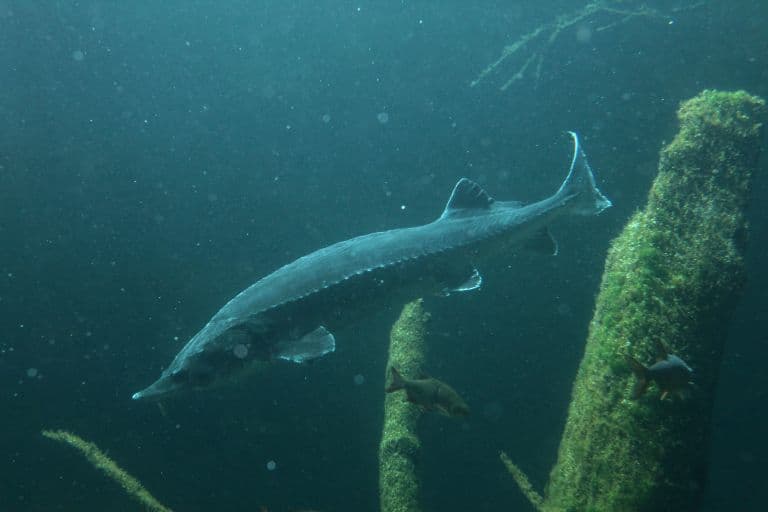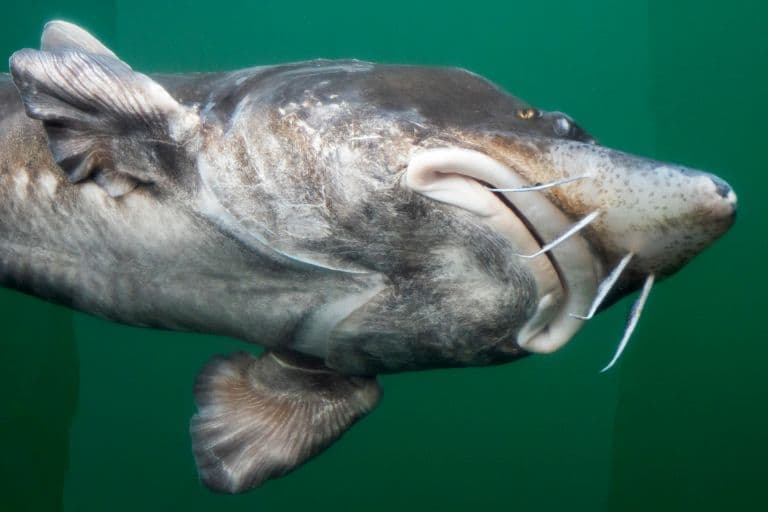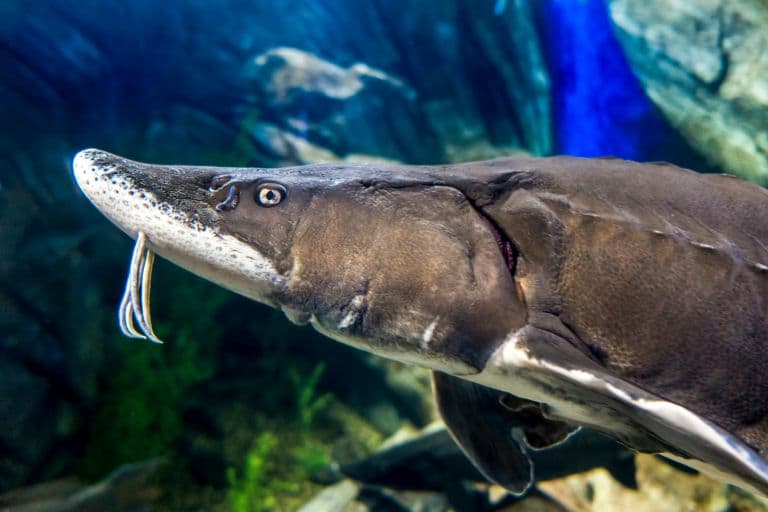Beluga Sturgeon Profile
One of the most expensive materials on earth comes from the gonads of a fish.
Beluga caviar reflects wealth inequality in its most blatant and destructive forms. While almost 10% of the planet goes hungry, elite consumer demands for $5,000 of fish eggs have almost wiped out one of the heaviest bony fish to ever live.
Once so abundant it was fed to peasants, these fish eggs are now apparently the best thing you can put in your mouth. So good, it’s worth driving the species to extinction.
The beluga sturgeon or ‘great sturgeon’, is a huge species of bony fish found in the Caspian and Black Sea basins.

Beluga Sturgeon Facts Overview
| Habitat: | Wetlands, shallow marine |
| Location: | Caspian Sea, Black Sea, Danube River |
| Lifespan: | Unknown, possibly over 100 years |
| Size: | Record length of 6.1 m (20 ft 0 in) |
| Weight: | Record weight of around 1571kg (3,463 lb) |
| Colour: | Dark grey, blue-grey |
| Diet: | Pelagic fish species |
| Predators: | Humans |
| Top Speed: | Unknown |
| No. of Species: | 1 |
| Conservation Status: | Critically endangered (IUCN) |
Beluga sturgeons are named after their color, which is about the only thing they share with their cetacean namesake. They’re a peculiar-looking fish and quite a unique and ancient line of bony giants with long faces.
But perhaps their biggest attribute is their immense size. We don’t know how big they can get because we always kill them before they can reach old age, but the ones on record rival that of Great Whites and Greenland sharks for the heaviest predatory fish.
Sadly, they have been all but wiped out, but some reintroduction programs show a little promise in bringing them back.
Interesting Beluga Sturgeon Facts
1. They’ve been around for a long time
The scientific name sounds like something the All-Blacks shout at the beginning of a rugby match, and it’s not obvious where the word comes from. In Latin, it means swine, and in old Germanic roots it appears to be derived from the word house.
The Sturgeon word comes from Germanic roots for “to stir”, or “to rummage about”, which this fish isn’t very good at. Unlike other sturgeon species, this one prefers to hunt free-swimming fish, rather than working as a bottom feeder.
The Beluga part appears to come from old Russian and refers to the colour ‘white’, which is likely a reference to it being much paler than other species. This explains why it shares its name with the whale, which is otherwise very unrelated.
Sturgeons are quite ancient-looking fish and come from an Early Jurassic ancestor around 200 million years ago. Their closest living relatives are the paddlefish, in the sister family Polyodontidae, and you can see the family resemblance in the extended snout and all-around weirdness of both animals.
And, like the paddlefish, sturgeons can grow to surprising lengths.
2. Beluga sturgeons are the third largest bony fish in the world
You wouldn’t know it, looking at their tiny eggs, but these are some of the biggest fish in the world. A record-breaking sturgeon reached over six meters long and weighed over 1,500kg.
If you were able to safely pluck a great white shark from its house and whack it on the scales, you’d notice that the largest predatory fish in the ocean only just tops the weight of our sturgeon friend here.
In fact, beluga sturgeons can grow to weights that you’d expect from beluga whales, and consequently, they are the largest freshwater fish in the world.
3. We don’t even know how big they can get
Sturgeons accomplish this through a phenomenon known as indeterminate growth, which essentially means where other animals come out of the gangly teenage stage and stop growing, sturgeons just keep on getting bigger as they age.
We don’t know how long they can do this for – it’s very possible they could grow to much larger sizes if people wouldn’t keep killing the largest of them. The majority of these fish never make it to old age and are instead hunted by people, and as such, as the years go by, the size of the biggest sturgeons alive is decreasing.
We know they can live longer than 80 years, and some say it’s likely they can top 100 and get a telegram from the monarch, but until we stop killing them for eggs, we aren’t likely to find out. 1
4. They change shape a lot
Fish usually develop very differently from more familiar animals like land mammals. In flounders, for example, they begin life as a normal-looking fish and then, as they age, their eyes migrate to one side of their face and they lie on the sea bed all sideways and unusual.
The adult sturgeon is a very distinctive beast, but to get there it goes through its own significant changes.
As sturgeons grow, their mouths change position until they go from being under the head, where you’d expect them to be, to being sort of stuck on the front of their face.
Juvenile sturgeons are the shape you’re likely most familiar with elongated with ridged backs and a long snout. This snout takes up half the head and gradually reduces as they mature.
By the time they’re adults, they look entirely different, being much bulkier, smoother, and with a shorter snout. Particularly old specimens are notable for their huge mouths.

5. They’re adaptable to different waters
Most water-living animals pick a salinity level they’re comfortable with and stick to it. Marine animals need to figure out how to hold prevent desiccation while getting rid of all the salt in their food, and freshwater animals have the opposite problem: they are always at risk of inflating like a water balloon from the osmotic pressure.
Whichever problem they have, these animals evolve to have very expensive and complex coping mechanisms like salt glands or power kidneys. These adaptations work well but generally limit the animal to one place or another.
Beluga sturgeons are impressively flexible in this regard. They’re known to handle a range of salinity and can move freely between brackish estuaries and fresh rivers. Perhaps as a result of this resilience, they’re also able to handle some of the most polluted waterways too.
Like bull sharks, they switch between these environments by adjusting the quality and amount of their urine. 2
6. Switching environments is a stressful process
While beluga sturgeons make this look easy, it’s actually quite a rough process to go through. Kidney processes change, the organs themselves actually physically change shape, and various systems undergo stressful alterations.
This whole process results in raised cortisol levels that can be fatal, particularly in juvenile fish. Higher salinity is associated with higher cortisol, and in some cases, this never goes back down.
So, while this is an impressive adaptation and a great way to improve the safety of breeding, it comes at a significant cost. 3

7. They’re hunted a lot
Beluga sturgeon rarely die of old age. Poachers and fishermen kill any large individual they can get their hands on, and so we have an upper limit to what we can learn about the mature stages of this species’ life cycle.
They’re hunted, not for their meat, but for their eggs. This delicacy is more expensive than printer ink and just as tasty and is considered by people with more money than sense to be the height of gourmet sophistication.
As a luxury product, a kilo of matter from the back end of this fish can set you back between $5,000 and $10,000 dollars. Caviar connoisseurs consider the consumption of these eggs a life-changing experience, and it certainly is for the fish.
Not too long ago, there were over 200,000,000 beluga sturgeons in the Caspian Sea, this population has seen a 90% decline in the past 60 years. 4
8. They’re critically endangered
You’d imagine a species worshipped to this degree by people with unjustifiable wealth would be doing rather well for itself but in reality, none of this money actually goes back to the sturgeon and exploitation has rendered the species almost extinct.
This may be the most massive fish to have ever lived, and we can no longer find out because the samples are getting so much smaller. While exceptional specimens once weighed closer to two tons, extreme outliers are now down to around 900kg.
A product this expensive will always attract poachers, and while the initial overharvest did much of the work to bring the species to the brink of extinction, poaching is now doing its share to keep this trend going.
Natural reproduction is now almost zero, as spawning grounds are being destroyed. Human development is increasing pollution to intolerable levels, even for this hardy species, and bycatch still causes trouble among the remaining populations.
More than 80% of spawning females between 17 and 29 years of age are now caught, and nearly 90% of males are between 11 and 23. These are the lower bounds of sexual maturity for the slow-growing fish, and it’s thought that even with full-on management, it can take half a century for populations to again stabilize and more than a century to recover. 5
9. Repopulation efforts are underway
In Italy, an official captive breeding program has been established and beluga sturgeon are being reintroduced.
Shoals of microchipped baby sturgeons were released into river systems to be tracked and monitored, and the species is hoped to establish itself in areas where it had become extinct in the wild.
In other places, reintroductions can’t keep up with the demand for their caviar, and results have been limited, but in the Danube, a WWF project saw 7,000 beluga sturgeon released into the Danube. The future is very uncertain for this colossal fish, but as long as the elites have money to burn, it’s likely there will be a powerful market for sturgeon poaching.
Beluga Sturgeon Fact-File Summary
Scientific Classification
| Kingdom: | Animalia |
| Phylum: | Chordata |
| Class: | Actinopterygii |
| Order: | Acipenserifomes |
| Family: | Acipenseridae |
| Genus: | Huso |
| Species: | Huso Huso |
Fact Sources & References
- “Huso huso Beluga”, Animal Diversity Web.
- L. S. Krayushkina (1996), “Changes in sodium, calcium and magnesium ion concentrations in sturgeon (Huso huso) urine and in kidney morphology”, Springer Link.
- S.M.V. Farabi(2007), “Study on salinity tolerance and some physiological indicators of ion-osmoregulatory system in juvenile Beluga, Huso huso (Linnaeus, 1758) in the south Caspian Sea: Effect of age and size”, Iranian Journal of Fisheries Sciences.
- “Beluga”, IUCN Red List.
- sahar (2021),“Beluga Caviar: One of the most sophisticated and famous caviar”, Caviar Lover.
